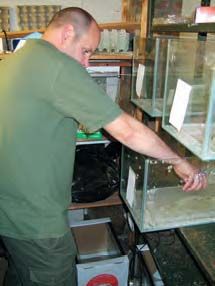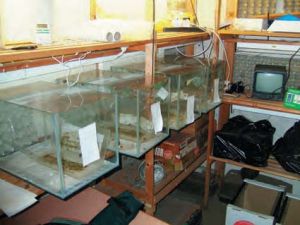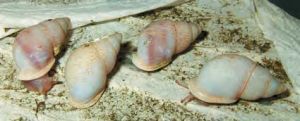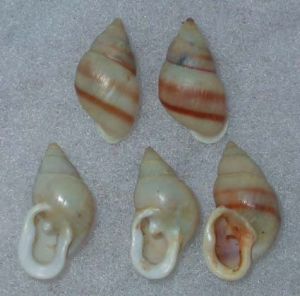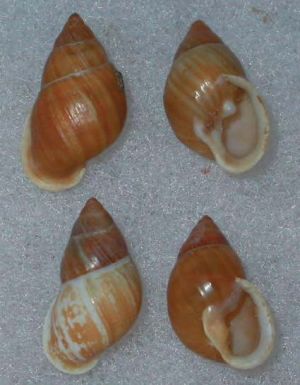|
Recently I was fortunate enough to have a behind the scenes visit to Edinburgh Zoo to see some of the conservation work they are doing. This came about as I had been doing research for a new display on endangered species for the Kelvingrove Museum and I had wanted to include more than just the usual fur and feather examples. After a bit of research and a look through our collections I thought that the sorry tale of the Partula snails of French Polynesia would be a perfect example of threatened molluscs. If you are not already aware of the sad background to the plight of the Partula then in a nutshell it is as follows. Giant African land snails (Achatina fulica) were introduced as a potential food source to several islands in French Polynesia in 1967, they didn’t breed well in captivity and were released into the wild where they flourished. Soon they started to eat the islanders’ crops and swift action needed to be taken. It was decided to fight a snail with a snail so the carnivorous rosy wolf snail (Euglandina rosea) was imported from Florida and released. Things did not go as planned, the wolf snails favoured prey is snails from about 18mm to 22mm long and seeing as how giant African land snails can reach 270mm long it soon became obvious that it wasn’t going to work. By this time it was too late and the wolf snails had started to decimate the local populations of Partula snails (whose average size is around 20mm long). It didn’t take long for many Partulids to become extinct and from around 100 species there are now thought to be less than 50 with many of these only surviving in captive bred populations. I soon found out that Edinburgh Zoo were part of the international effort to breed Partula snails in captivity for eventual reintroduction back into the wild. Edwin Blake (Fig. 1) is the keeper in charge of reptiles and birds at Edinburgh Zoo but he has also branched into molluscs and is the man responsible for breeding and looking after the snails. A few years ago he was fortunate enough to go on a trip to the South Pacific where he was able to see first hand the destruction caused by the introduction of Euglandina. After finding only tens of snails where previously there had been thousands he brought some back to the UK. The zoo currently has seven species of Partula from several different islands. They are kept in tanks (Fig. 2) in what appears to be a garden shed in the backgrounds of the zoo. Despite its humble appearance it is one of the best environments, in terms of breeding success, of any of the zoos involved in the scheme. Partulids are ovoviviparous meaning they give birth to live young after their eggs have hatched inside them. These young emerge fully formed but not much bigger than a breadcrumb and can often be hard to find when counts need to be done. Getting the conditions just right for the snails has been a hard learning curve, the right temperature, humidity, substrate and so on had to be found out by trial and error. Partula snails in the wild eat dead leaves; in captivity they are fed a ground up mixture of grass pellets, oats, powdered cuttlebone, trout pellets and multi vitamins. This is spread on to tissues on top of Perspex sheets and then placed in the tanks; the snails scrape the feed off the sheets mimicking their feeding habits in the wild (Fig. 3) As the zoo has been breeding snails for several years now they have built up a small collection of shells and Edwin was kind enough to let me take a few of the more numerous ones for the Glasgow Museums collections. P. suturalis and P. tohiveana were reintroduced to probably the smallest reserve in the world on the island of Tahiti a couple of years ago. With a special perimeter designed to keep out the wolf snails. Initial signs are good but there is still a long way to go before the Partula are free to roam once again. Amongst the collections at Glasgow Museums we have many more Partula snails along with examples of other endangered land snails from small islands around the world such as Liguus tree snails and Achatinella snails. I would be delighted to hear from anyone keen to study any of these specimens. |
Fig.1 (Photo Mike Rutherford)
Fig.2 (Photo Mike Rutherford)
Fig.3 (Photo Mike Rutherford)
Fig.4 Partula rosea has an all white sinstrally coiled shell and was found on Raiatea Island. (Photo Mike Rutherford)
Fig. 5 Partula tohiveana has a pale brown shell and comes from Mount Tohiea on Moorea Island. (Photo Mike Rutherford)
Fig. 6 Partula hebebela has a small white shell with pink tip and was collected in huge numbers, to make into necklaces, by the islanders from Huahine Island. (Photo Mike Rutherford)
Fig. 7 Partula mirabilis has a small brown shell and comes from coastal valleys on Moorea Island. (Photo Mike Rutherford)
Fig. 8 Partula suturalis or a subspecies from lowland valleys of Moorea Island (Photo Mike Rutherford)
Fig. 9 Partula affinis is a small blackbodied snail, which despite being listed as extinct by the IUCN seems to be doing okay at the zoo! (Photo Mike Rutherford) |
Partula snails at Edinburgh Zoo
Issue
9
Page
13

